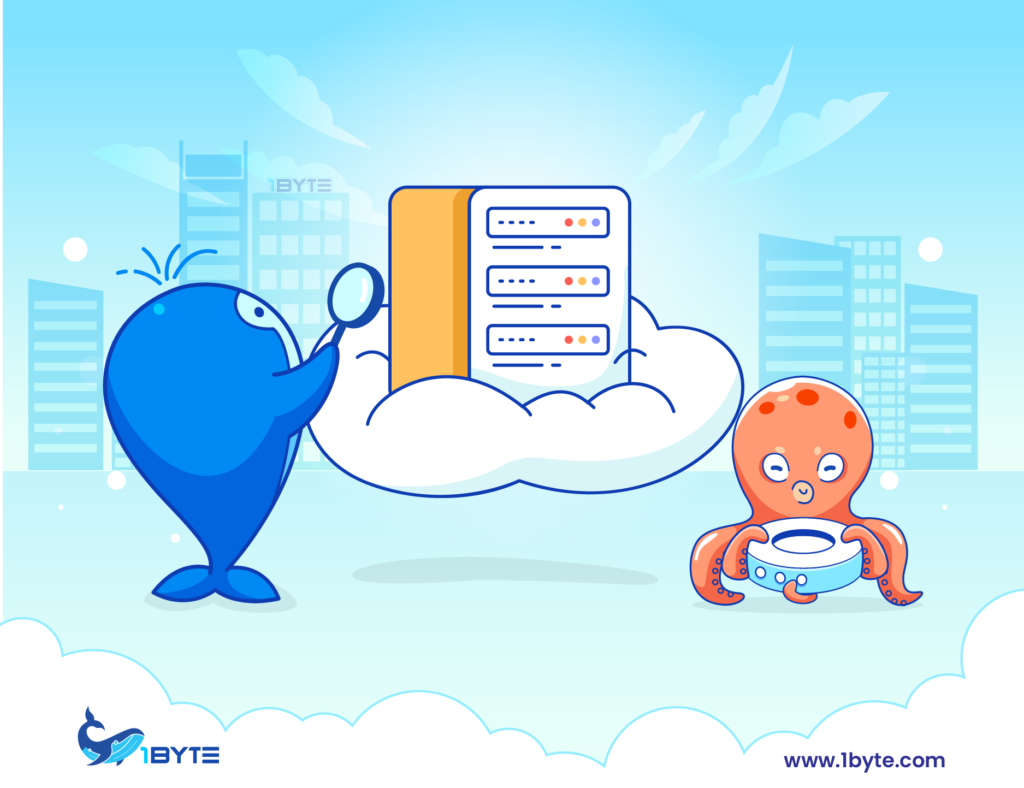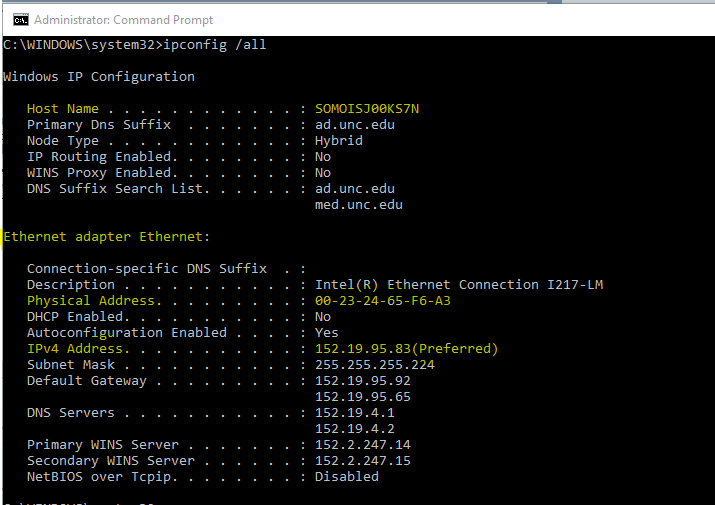Ever wondered, “What is my server address?” Understanding this vital piece of information is crucial for effective online management. Your server address is like the digital home for your website, and knowing it empowers you in various ways. In this simple guide from 1Byte, we’ll break down the process, ensuring that even if you’re not tech-savvy, you’ll confidently navigate the steps to unveil your server address. Ready to demystify the technical jargon and gain control over your online presence? Let’s dive in and discover the key to your website’s digital identity.
What Is a Server Address?
Curious about the digital backbone of your website? “What is my server address?” is a common question, and to answer it, let’s first understand what a server address is.
FURTHER READING: |
| 1. Top 10 AI Website Builders You Should Know |
| 2. The Role of Enterprise Networks |
| 3. Data Center Migration Strategy: Lessons from 5 Real-Life Cases |
Definition of a server address
A server address, in straightforward terms, is the unique numerical label assigned to your server. This numeric identifier, often referred to as an IP address, serves as the digital equivalent of a street address for your website. It tells other devices on the internet where to find your site and how to connect with it. Think of it as your website’s personal phone number in the vast digital phone book of the internet.
This string of numbers functions much like a GPS coordinate for online traffic. When someone types your website’s domain name into their browser, the system consults the server address to locate and display the requested content. It’s the behind-the-scenes navigation that ensures a seamless connection between users and your web server.
Understanding this essential component is akin to grasping the essence of how your website communicates and functions in the digital realm. Without this unique server address, the internet wouldn’t know where to direct the requests for your website, making it a fundamental aspect of your online presence. So, as you embark on uncovering “what is my server address,” remember that it’s the digital key to unlocking the doors of your website to the world.
A server address’ role in internet communication
A server address is the backbone of internet communication, serving as a unique identifier for devices on a network. This numerical label, often in the form of an IP address, plays a pivotal role in facilitating seamless communication between computers, printers, and other connected devices.
In the realm of server addresses, the most common type is the IP address, composed of four groups of numbers separated by periods. These numerical combinations, ranging from 0 to 255, uniquely identify and locate devices on the network. Alternatively, a domain name, a more user-friendly identifier, serves a similar purpose by pointing to a specific website or server on the internet.

Consider the server address 192.168.1.1 as an example. This numeric code functions as a digital address for a device on the internet, enabling communication between devices. Without this unique identifier, the internet would lack the foundational structure needed for devices to interact effectively.
The significance of a server address becomes evident when devices want to connect with each other. When a device initiates a connection, it utilizes the server address to send a request. The server, in turn, responds by providing the requested information. This communication process is essential for the internet to function, emphasizing the crucial role of server addresses in maintaining connectivity.
Beyond basic internet communication, server addresses are integral to specific services like remote desktop and file sharing. For instance, when seeking to connect to a remote computer for file sharing, knowledge of the server address is imperative. In essence, a server address acts as the digital communicator, ensuring devices can effectively share information and services across the vast landscape of the internet.
Importance for website owners and administrators
For website owners and administrators, the importance of server addresses cannot be overstated. These unique identifiers are the linchpin for various critical aspects of online operations.
Business Continuity is paramount in the digital realm. Server administration ensures high performance and safeguards valuable data and mission-critical applications. Acting as the core of operations, proper server management becomes indispensable for protecting and managing digital assets.
Security remains a top priority. With a surge in cyberattacks, server administrators must adopt a proactive approach to cybersecurity. Effective server administration is a key player in fortifying digital defenses against evolving threats.
Website Accessibility is directly tied to server addresses. Web servers store and deliver files to browsers, enabling user access to sites. The seamless retrieval of relevant files by the web server ensures a smooth interaction between users and websites.
Data Exchange is facilitated through server addresses. Web servers employ Hypertext Transfer Protocol (HTTP) to respond to user requests on the World Wide Web. This process allows servers to deliver a site’s HTML document to the user’s web browser, enabling data exchange.
Efficiency and Maintenance are pivotal considerations. Servers, powering IT functions like data storage, web hosting, emails, and app functionalities, demand continual management. Regular maintenance ensures longevity, efficiency, and robust security for these central components.
Consider a practical scenario where a website owner aims to update their site. Accessing the server where the website is hosted is imperative, achieved through the server address. This access empowers the owner to make necessary changes to the website, illustrating the critical role of server addresses in routine website management. Without this key, accessing the server and updating the website would be impossible, underscoring the vital role that server addresses play in the hands of website owners and administrators.
Why You Need to Know Your Server Address
Understanding “what is my server address” is not just a technical query but a fundamental necessity for anyone navigating the digital landscape. Why, you may wonder? The answer lies in the pivotal role that your server address plays in ensuring a seamless and secure online experience.
Connection to website management and troubleshooting
Knowing “what is my server address” establishes a direct connection to effective website management and troubleshooting. This unique identifier serves as the digital roadmap for individuals involved in overseeing and optimizing their online presence.
For website managers, the server address is the gateway to the heart of operations. When updates or changes are required, understanding and using the server address is essential. Imagine wanting to make adjustments to your website’s content or layout — this process begins with accessing the server using the server address.
Troubleshooting becomes more accessible when armed with the knowledge of your server address. In cases of technical glitches, errors, or website malfunctions, having this identifier allows administrators to pinpoint and address issues promptly. It’s akin to having the right set of tools to diagnose and fix problems efficiently.
Moreover, the server address empowers website managers to take proactive measures. Regularly checking and updating the server ensures smooth website functioning, preventing potential disruptions. In the dynamic landscape of the internet, where digital landscapes are ever-evolving, the ability to troubleshoot and manage a website efficiently is a significant advantage.
In summary, the server address is not merely a string of numbers; it is the key to unlocking the potential for seamless website management and effective troubleshooting. The knowledge of “what is my server address” positions individuals to navigate the digital realm with confidence, ensuring that their online presence remains dynamic, secure, and resilient.
Security implications and best practices
Understanding “what is my server address” goes beyond mere technicalities; it’s a crucial step towards fortifying the security of your online assets. The server address, being the digital key to your website, plays a pivotal role in safeguarding sensitive information and maintaining a resilient online presence.
Security implications are paramount. With a staggering 50% increase in cyberattacks on corporate networks in 2021, the need for a proactive cybersecurity approach cannot be overstated. Knowing your server address equips administrators with a foundational element for securing their servers against evolving threats.

Best practices hinge on the knowledge of your server address. Regularly updating and securing the server is essential in the face of emerging cyber threats. This proactive approach helps create a robust defense mechanism, reducing the vulnerability of the server to potential breaches.
Moreover, having a clear understanding of the server address facilitates swift responses to security incidents. In the unfortunate event of a breach or suspicious activity, administrators can quickly identify and isolate the affected areas, minimizing the potential impact on the overall system.
For cybersecurity, prevention is key. The server address is a critical component in implementing best practices that shield your website from potential vulnerabilities. By staying informed and proactive, website owners and administrators can create a formidable defense against the ever-evolving landscape of online threats.
Benefits of having this information readily available
Knowing “what is my server address” offers a multitude of benefits, providing website owners and administrators with a strategic edge in managing their digital assets effectively.
The foremost advantage lies in Efficient Troubleshooting. With the server address readily available, administrators can swiftly diagnose and address issues, ensuring minimal downtime and optimal website performance.
Enhanced Security Measures are a natural outcome of having this information at hand. Administrators can proactively implement security protocols, fortifying the server against potential threats and safeguarding sensitive data.
When considering Website Updates and Maintenance, having the server address simplifies the process. Whether it’s updating content, changing configurations, or enhancing security features, this information streamlines the management of the website.
Furthermore, the knowledge of the server address ensures Seamless Communication. When devices need to connect or exchange information, this unique identifier facilitates smooth interactions, enabling the website to function as intended.
3 Methods to Find Your Server Address
Unlocking the mystery behind “what is my server address” involves practical steps, and in this section, we’ll explore three straightforward methods to find this essential piece of information.
Method 1: Using Command Prompt (Windows)
To uncover what your server address is using the Command Prompt on Windows, follow these straightforward steps:
- Access the Command Prompt:
Open the Command Prompt by clicking on the Start icon, typing “Command Prompt” into the search bar, and pressing Enter.
- Enter the Command:
In the Command Prompt window, type the command:
ipconfigPress Enter to execute the command.
- View Network Interfaces:
The executed command will present a list of all network interfaces on your computer, accompanied by their respective IP addresses.
- Identify the IPv4 Address:

Locate the line that says “IPv4 Address.” The number following this line is your local IP address or server address.
- Note on Public IP Address:
Keep in mind that this method reveals your local IP address. For the public IP address visible to the outside world, you can use the following command in the Command Prompt:
nslookup myip.opendns.comThis command will provide your public IP address.
By following these steps, users can swiftly and easily find their server address using the Command Prompt on a Windows system. This method is especially useful for individuals looking to manage and troubleshoot their local network connections.
Method 2: Terminal (Mac and Linux)
To uncover “what is my server address” using the Terminal on Mac and Linux, follow these simple steps:
- Access the Terminal:
Open the Terminal application on your Mac or Linux system.
- Enter the Command:
In the Terminal window, type the following command:
ifconfig -aPress Enter to execute the command.
- View Network Interfaces:
The executed command will display a comprehensive list of all network interfaces on your computer, accompanied by their respective IP addresses.
- Identify the inet addr:

Look for the line that says “inet addr.” The number following this line is your local IP address or server address.
- Note on Public IP Address:
Please be aware that this method reveals your local IP address. For the public IP address visible to the outside world, use the following command in the Terminal:
curl ifconfig.meThis command will provide your public IP address.
By following these steps, users can swiftly and easily find their server address using the Terminal on Mac and Linux systems. This method is particularly useful for individuals looking to manage and troubleshoot their local network connections in an efficient manner.
Method 3: Checking Hosting Provider Dashboard
Discovering “what is my server address” through your hosting provider’s dashboard is a straightforward process. Follow these user-friendly steps:
- Login to the Dashboard:
Log in to your hosting provider’s dashboard using your credentials.
- Locate General Information:
Navigate to the right-hand sidebar and find the “General Information” section.
- Access Server Information:
Within the General Information section, look for and click on the “Server Information” link.
- Retrieve Server Details:
A new window will appear, displaying your Server Name and Shared IP Address.
- Note on Variations:
Keep in mind that steps may slightly differ based on your hosting provider. If uncertain, reach out to your hosting provider’s support for specific instructions.
By following these steps, users can effortlessly retrieve their server address directly from their hosting provider’s dashboard. This method is particularly beneficial for those who prefer a streamlined approach or may not be comfortable using command-line interfaces.
Leverage 1Byte’s strong cloud computing expertise to boost your business in a big way
1Byte provides complete domain registration services that include dedicated support staff, educated customer care, reasonable costs, as well as a domain price search tool.
Elevate your online security with 1Byte's SSL Service. Unparalleled protection, seamless integration, and peace of mind for your digital journey.
No matter the cloud server package you pick, you can rely on 1Byte for dependability, privacy, security, and a stress-free experience that is essential for successful businesses.
Choosing us as your shared hosting provider allows you to get excellent value for your money while enjoying the same level of quality and functionality as more expensive options.
Through highly flexible programs, 1Byte's cutting-edge cloud hosting gives great solutions to small and medium-sized businesses faster, more securely, and at reduced costs.
Stay ahead of the competition with 1Byte's innovative WordPress hosting services. Our feature-rich plans and unmatched reliability ensure your website stands out and delivers an unforgettable user experience.
As an official AWS Partner, one of our primary responsibilities is to assist businesses in modernizing their operations and make the most of their journeys to the cloud with AWS.
Conclusion
Concluding this simple guide on “what is my server address,” users now possess the tools to effortlessly uncover this critical piece of information. Whether delving into the Command Prompt or Terminal or navigating their hosting provider’s dashboard, individuals can confidently manage their online presence.
By understanding their server address, users gain the ability to troubleshoot, secure, and maintain their websites efficiently. This knowledge is not just technical; it’s a strategic advantage in the dynamic digital landscape.
In a world where online security and effective website management are paramount, knowing “what is my server address” is akin to holding the keys to one’s digital kingdom. Empowered with this information, users can navigate the complexities of the internet, ensuring their online presence remains resilient and secure. Remember, your server address is the key to unlocking a seamless and secure online experience.

